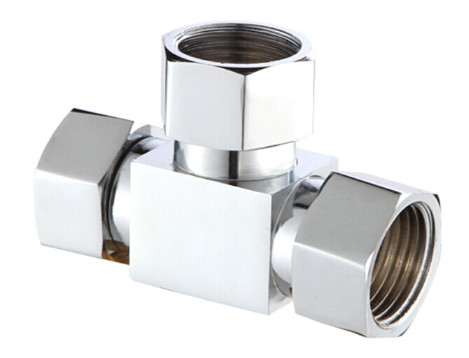Pipe fittings are essential components in plumbing, heating, and cooling systems, enabling the connection, redirection, or control of fluid flow in pipelines. This guide provides a detailed, technical overview of pipe fittings, including their types, materials, specifications, and applications. Designed for professionals and engineers, it focuses on systematic information to support decision-making in industrial, commercial, and residential projects.
Definition and Purpose of Pipe Fittings
Pipe fittings, also known as pipe connectors, are used to join pipes, alter flow direction, regulate flow, or terminate pipelines. They ensure system integrity by providing leak-proof connections and enabling adaptability in complex piping layouts. Fittings are critical in industries such as oil and gas, water treatment, chemical processing, and HVAC systems, as well as in residential plumbing.
The primary functions of pipe fittings include:
- Connecting pipes of the same or different diameters.
- Redirecting flow through bends or branches.
- Controlling flow with valves or reducers.
- Sealing pipe ends to prevent leaks.
Types of Pipe Fittings
Pipe fittings are categorized based on their function and design. Below is a systematic breakdown of the most common types, including their applications and technical specifications.
Elbows
Elbows change the direction of flow in a piping system, typically at angles of 45° or 90°. They are used in systems requiring bends to navigate obstacles or fit within confined spaces.
- Material Options: Carbon steel, stainless steel, PVC, copper.
- Sizes: 1/8" to 48" nominal pipe size (NPS).
- Pressure Ratings: ANSI/ASME B16.9 standards, up to 6000 psi for high-pressure systems.
- Applications: Plumbing, gas distribution, chemical plants.
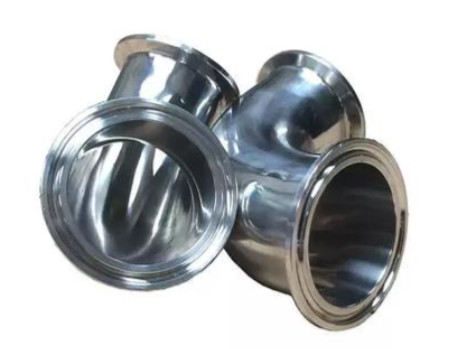
Tees
Tees create a branch in a pipeline, allowing fluid to flow in two directions from a single source. They are available in equal or reducing configurations.
- Types: Equal tee (same diameter for all openings), reducing tee (branch diameter smaller than main).
- Material: Malleable iron, brass, HDPE, stainless steel.
- Specifications: Conforms to ASTM A234 for carbon steel, wall thickness Sch 40 or Sch 80.
- Applications: Water distribution, oil refineries, HVAC systems.
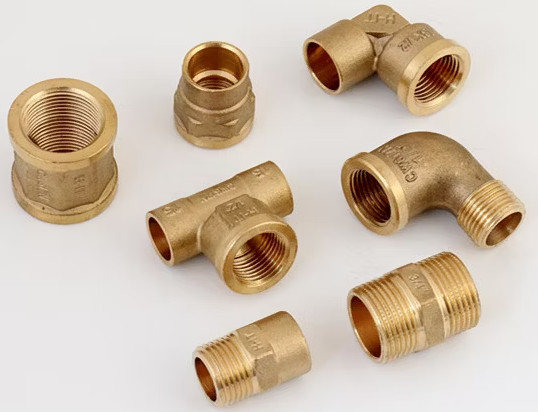
Couplings
Couplings connect two pipes to extend a pipeline or repair a break. They are available as full couplings (permanent) or half couplings (threaded on one end).
- Connection Types: Threaded, socket weld, or compression.
- Sizes: 1/4" to 12" NPS.
- Pressure Ratings: Up to 3000 psi for threaded couplings.
- Applications: Residential plumbing, industrial fluid transport.
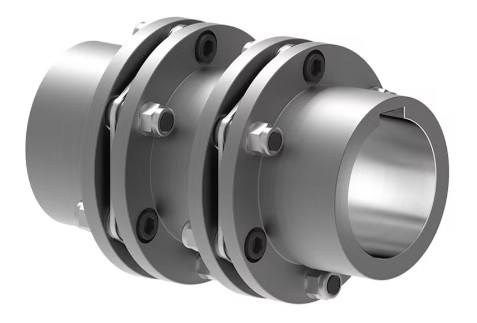
Reducers
Reducers connect pipes of different diameters, facilitating a smooth transition in flow. They are available as concentric (aligned centerline) or eccentric (offset centerline).
- Material: Carbon steel, PVC, copper, alloy steel.
- Specifications: ASME B16.9, wall thickness matching pipe schedule.
- Applications: Pump systems, chemical processing, wastewater treatment.
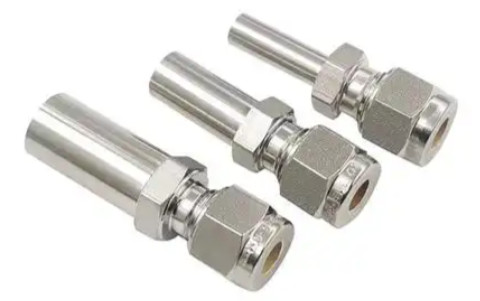
Unions
Unions allow easy disconnection of pipes for maintenance or replacement. They consist of three parts: a nut, a female end, and a male end.
- Material: Stainless steel, brass, PVC.
- Sizes: 1/8" to 4" NPS.
- Pressure Ratings: Up to 1500 psi for stainless steel unions.
- Applications: Plumbing, gas lines, industrial maintenance.
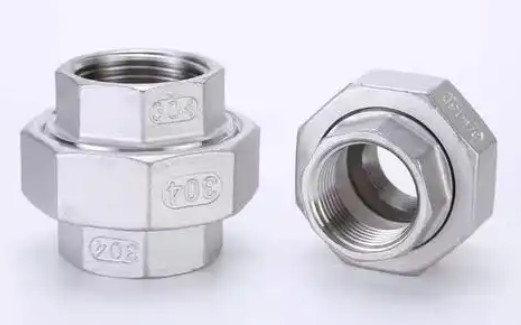
Valves
Valves control flow by opening, closing, or partially obstructing pipelines. Common types include gate, ball, check, and globe valves.
- Types: Ball (quarter-turn), gate (linear motion), check (one-way flow).
- Material: Bronze, stainless steel, cast iron.
- Specifications: API 6D for pipeline valves, pressure classes 150–2500.
- Applications: Oil and gas, water supply, HVAC control.
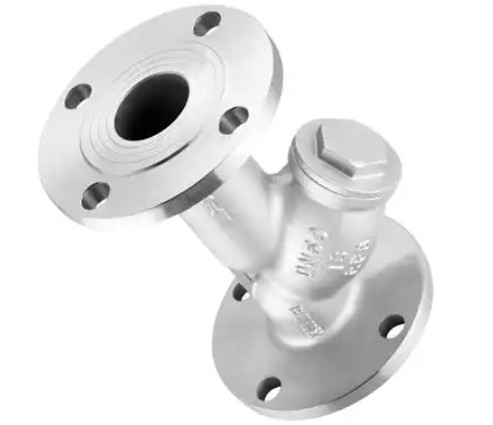
Materials Used in Pipe Fittings
The choice of material for pipe fittings depends on the application, fluid type, pressure, and environmental conditions. Below is a table summarizing common materials and their properties.
| Material | Properties | Applications |
|---|---|---|
| Carbon Steel | High strength, cost-effective, moderate corrosion resistance | Oil and gas pipelines, industrial systems |
| Stainless Steel | Corrosion-resistant, durable, high-pressure tolerance | Chemical plants, food processing, marine |
| PVC | Lightweight, corrosion-resistant, non-conductive | Water supply, drainage, irrigation |
| Copper | Excellent thermal conductivity, corrosion-resistant | HVAC, potable water systems |
| Brass | Corrosion-resistant, good machinability | Plumbing, gas fittings |
Connection Methods for Pipe Fittings
Pipe fittings are connected using various methods, each suited to specific applications and pressure requirements. The choice of connection impacts installation ease, maintenance, and system reliability.
Threaded Connections
Threaded fittings have internal or external threads, allowing pipes to be screwed together. They are common in low-pressure systems.
- Standards: NPT (National Pipe Thread), BSP (British Standard Pipe).
- Advantages: Easy to install, no welding required.
- Limitations: Not suitable for high-pressure systems above 1500 psi.
- Applications: Residential plumbing, gas lines.
Socket Weld Connections
Socket weld fittings involve inserting a pipe into a recessed area of the fitting, followed by welding. They are used in high-pressure systems.
- Standards: ASME B16.11 for forged fittings.
- Advantages: Strong, leak-proof joints.
- Limitations: Requires skilled welding, permanent connection.
- Applications: Chemical plants, oil refineries.
Butt Weld Connections
Butt weld fittings are welded directly to the pipe end, creating a smooth, continuous pipeline. They are ideal for large-diameter, high-pressure systems.
- Standards: ASME B16.9 for seamless fittings.
- Advantages: High strength, suitable for extreme conditions.
- Limitations: Time-consuming installation, requires precision.
- Applications: Power plants, petrochemical industries.
Compression Fittings
Compression fittings use a ferrule to compress the pipe, creating a tight seal. They are used in systems requiring frequent disassembly.
- Advantages: No welding or threading required, easy to install.
- Limitations: Limited to low-pressure systems (up to 500 psi).
- Applications: Refrigeration, hydraulic systems.
Standards and Specifications
Pipe fittings must adhere to industry standards to ensure safety, compatibility, and performance. Key standards include:
- ASME B16.9: Covers factory-made wrought steel butt-welding fittings.
- ASME B16.11: Specifies forged steel fittings for socket weld and threaded connections.
- ASTM A234: Defines material properties for carbon and alloy steel fittings.
- API 6D: Governs pipeline valves for oil and gas industries.
- ANSI/ASME B1.20.1: Standardizes NPT threads for threaded fittings.
Compliance with these standards ensures fittings meet pressure, temperature, and corrosion resistance requirements. For example, ASME B16.9 fittings are tested for burst pressure, typically exceeding 4 times the rated pressure.
Applications of Pipe Fittings
Pipe fittings are used across various industries and applications, each requiring specific types and materials. Below is a table summarizing key applications.
| Industry | Fitting Types | Material | Examples |
|---|---|---|---|
| Oil and Gas | Elbows, tees, reducers | Carbon steel, stainless steel | Pipeline transport, refineries |
| Water Treatment | Couplings, valves, tees | PVC, stainless steel | Water purification, distribution |
| HVAC | Elbows, unions, valves | Copper, brass | Heating and cooling systems |
| Chemical Processing | Tees, reducers, valves | Stainless steel, alloy steel | Chemical reactors, storage |
Selection Criteria for Pipe Fittings
Choosing the right pipe fitting involves evaluating several parameters to ensure compatibility and performance:
- Fluid Type: Corrosive fluids require materials like stainless steel or PVC.
- Pressure and Temperature: High-pressure systems need butt-weld or socket-weld fittings.
- Pipe Size: Fittings must match the nominal pipe size (NPS) and schedule.
- Installation Environment: Outdoor systems may require UV-resistant or corrosion-resistant materials.
- Maintenance Needs: Unions or compression fittings are ideal for systems requiring frequent disassembly.
Installation and Maintenance Considerations
Proper installation and maintenance of pipe fittings are critical to system longevity and safety. Key considerations include:
- Alignment: Misaligned fittings can cause leaks or stress fractures.
- Torque: Over-tightening threaded fittings can damage threads, while under-tightening can cause leaks.
- Inspection: Regular checks for corrosion, wear, or cracks are essential, especially in high-pressure systems.
- Cleaning: Fittings in potable water systems must be cleaned to prevent contamination.
For welded fittings, non-destructive testing (e.g., X-ray or ultrasonic testing) ensures weld integrity. In high-corrosion environments, applying protective coatings or using cathodic protection can extend fitting life.
Conclusion
Pipe fittings are integral to the functionality and safety of piping systems across industries. Understanding their types, materials, connection methods, and specifications enables engineers and professionals to design and maintain efficient systems. By adhering to industry standards and carefully selecting fittings based on application requirements, you can ensure reliable performance and longevity. This guide provides a technical foundation for making informed decisions about pipe fittings in any project.
